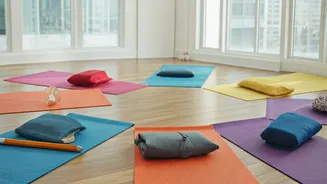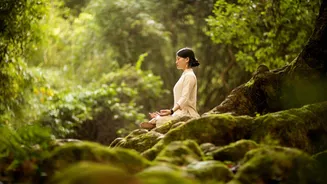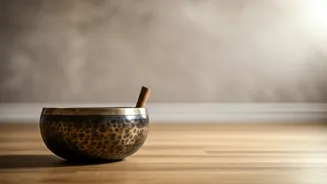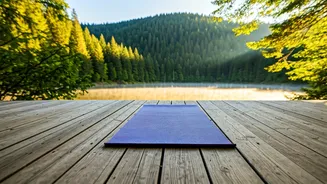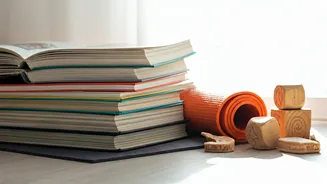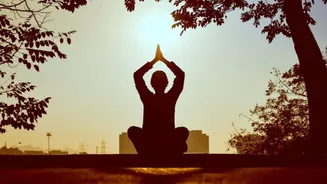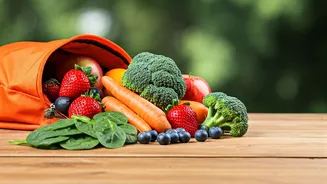Introduction: Yoga’s Benefits
Yoga, an ancient practice, offers numerous benefits for both children and adults. For kids, it's particularly effective in enhancing cognitive functions.
Regular yoga practice can boost memory, improve concentration, and reduce stress levels. Unlike intense physical activities, yoga combines physical postures (asanas), breathing techniques (pranayama), and meditation, providing a holistic approach to well-being. This comprehensive method cultivates mindfulness, improves focus, and enhances overall mental clarity, making it an excellent tool for children’s development. The following yoga poses are specifically chosen for their ability to promote these cognitive advantages. By incorporating these poses into your child’s routine, you can create a positive impact on their mental capabilities and their ability to cope with daily challenges.
Mountain Pose (Tadasana)
Mountain Pose, or Tadasana, is a foundational yoga pose that promotes stability and focus. To perform this pose, have your child stand tall with their feet firmly planted on the ground, toes pointing forward, and arms by their sides. Encourage them to imagine a string pulling them upwards from the crown of their head, keeping their spine straight and shoulders relaxed. Mountain Pose aids in grounding the body, which helps improve concentration and cultivates a sense of presence. It teaches children to be mindful of their posture and to maintain balance, both physically and mentally. Regular practice of this pose helps improve body awareness and mental stability. When practicing with children, you can make the pose engaging by asking them to imagine they are a strong, tall mountain, unyielding to the wind.
Tree Pose (Vrikshasana)
Tree Pose, or Vrikshasana, enhances balance and focus. Ask your child to stand with one foot on the inner thigh or calf of the other leg, avoiding the knee. Their hands can be brought together in a prayer position at the chest or raised above their head like branches. Maintaining balance in this pose requires intense focus, which, in turn, strengthens their concentration skills. Tree Pose fosters a sense of calm and helps to improve coordination. It also encourages children to be aware of their body’s position in space. The key to successful performance in this pose is a steady gaze at a fixed point, which aids in maintaining balance and improving focus. Practicing this pose regularly helps develop the mental stamina needed to concentrate for extended periods.
Warrior II (Virabhadrasana II)
Warrior II, or Virabhadrasana II, is excellent for building strength and focus. To begin, have your child step one leg forward, bending the front knee at a right angle. The back leg should be straight, with the foot turned slightly outward. Extend their arms to the sides, parallel to the ground, and gaze over the front hand. Warrior II demands both physical strength and mental concentration. This pose strengthens the legs and core, while the focus required to maintain the posture enhances mental clarity. It helps children develop a sense of self-assurance and promotes a feeling of empowerment. Regular practice improves overall stability and teaches them how to stay centered, even when facing challenges.
Triangle Pose (Trikonasana)
Triangle Pose, or Trikonasana, stretches the body and sharpens the mind. Start with legs wide apart, turning one foot outward. Bend at the hip, reaching one hand towards the foot while the other arm reaches upwards. Gaze at the raised hand. This pose promotes flexibility and concentration. It requires children to maintain their balance while stretching, thereby improving their ability to focus. Triangle Pose also enhances coordination and body awareness. This pose not only strengthens the legs and core but also opens the chest, helping to increase oxygen flow to the brain, which in turn benefits cognitive functions. Practicing Triangle Pose regularly provides an overall boost to both physical and mental well-being.
Bridge Pose (Setu Bandhasana)
Bridge Pose, or Setu Bandhasana, is a gentle backbend that invigorates the brain and calms the mind. Your child should lie on their back with knees bent and feet flat on the floor, close to the buttocks. Lift the hips off the ground, supporting the body with their shoulders and feet. Clasp hands underneath if comfortable. This pose improves blood flow to the brain, boosting memory and concentration. It is also known to relieve stress and ease anxiety. Bridge Pose strengthens the back muscles and stretches the chest and spine. It helps children develop a sense of self-awareness and calmness. The gentle backbend opens up the chest, allowing for deeper breathing, which enhances the oxygen supply to the brain, improving focus.
Child's Pose (Balasana)
Child's Pose, or Balasana, is a calming pose that reduces stress and improves focus. Your child can kneel with their knees together (or slightly apart for comfort) and bring their forehead to the floor, resting their arms by their sides. This restorative pose provides a moment of rest and reflection, calming the mind and reducing anxiety. Child’s Pose is excellent for improving concentration and reducing mental fatigue. It encourages children to be present and to center themselves. It is a fantastic pose to use between more challenging poses to allow the child's body and mind to relax and recharge. Regularly incorporating Child’s Pose into their yoga routine helps children learn to manage stress and improve their ability to focus.
Cobra Pose (Bhujangasana)
Cobra Pose, or Bhujangasana, stimulates the mind and improves concentration. Have the child lie on their stomach with hands under their shoulders and elbows close to the body. Push up, lifting the chest off the floor, while keeping the lower body on the ground. This pose is invigorating, increasing energy levels and improving focus. Cobra Pose helps to strengthen the spine and open the chest, enhancing blood flow to the brain. It also improves mood and reduces feelings of stress. Regular practice of this pose helps children build confidence and improve their ability to focus. It provides a burst of energy, which aids in mental alertness and enhances memory.
Seated Forward Bend (Paschimottanasana)
Seated Forward Bend, or Paschimottanasana, calms the mind and enhances memory. Ask your child to sit with legs extended forward, then bend forward from the hips, reaching for their toes (or as far as they comfortably can). This pose encourages focus and self-awareness. It stretches the spine and releases tension, promoting a sense of calm. Seated Forward Bend improves blood circulation and helps in reducing stress. By calming the mind, this pose allows children to focus better and aids in improving their memory. Regular practice helps increase the child's attention span and promotes a sense of inner peace. It helps to bring the focus inward, which improves concentration and learning.
Conclusion: Mindful Practice
Incorporating these 10 yoga asanas into a child's routine can significantly improve their memory and concentration. Regular practice encourages mindfulness, reduces stress, and enhances overall well-being. It is recommended to create a consistent practice schedule, making it fun and engaging for kids. Encourage children to focus on their breath and to be present in each pose. Combine these poses with other healthy habits, such as a balanced diet and adequate sleep, to maximize the benefits. By adopting yoga, children can develop essential skills to navigate academic and social challenges more effectively. Remember, consistency is key, and the benefits of these practices become more pronounced with time.


